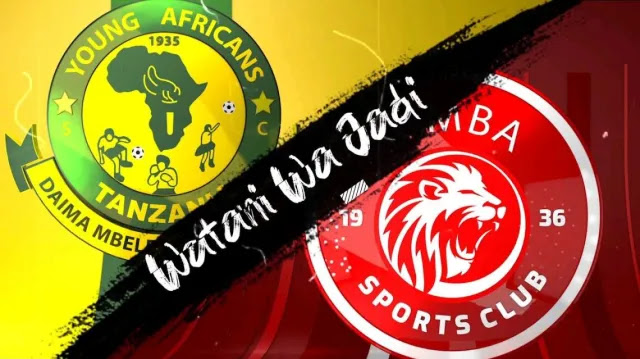der‧by /ˈdɑːbi $ ˈdɜːrbi/ noun (plural derbies) [countable] 1 → Derby2 British English a sports match between two teams from the same area or city3 especially American English a man’s hard round hat that is usually black SYN bowler British English4 a particular type of race or competition a donkey derby.
1. proper noun [the N]
The Derby is the name of a race for three-year-old horses that takes place each year. In the United States, it refers particularly to the Kentucky Derby.
Usiyoyajua kuhusu derby ya kariakoo ya jumapili Novemba 5
2. countable noun [oft n N]
A derby is a sports competition or race where there are no restrictions or limits on who can enter.
[US]
He caught a 6 pound salmon in the annual fishing derby at Lake Winnipesaukee.
Synonyms: competition, event, championship, tournament More Synonyms of derby
3. countable noun
A derby is a round, hard hat with a narrow brim which is worn by men. Derbies are no longer very common.
[US]regional note: in BRIT, usually use bowler hat
Origins
The tower of Derby Cathedral.[4]
View of Derby Cathedral's facing clock tower
The Roman camp of Derventio is considered to have been at Little Chester/Chester Green (grid reference SK353375), the site of the old Roman fort. Later, the town was one of the "Five Boroughs" (fortified towns) of the Danelaw, until it was captured by Lady Æthelflæd of Mercia in July 917, after which the town was annexed to the Kingdom of Mercia.[5]
The Viking name Djúra-bý, recorded in Old English as Deoraby, means "village of the deer". However, the origin of the name Derby has had multiple influences: a variation of the original Roman name Derventio with pronunciation of the letter "v" as "b", becoming Derbentio, and later Derby, along with a link to the river Derwent – from the Celtic meaning "valley thick with oaks"[6] – which flows through the city, triggering a shortened version of Derwent by, meaning 'Derwent settlement'.
The town name appears as Darbye on early maps, such as that of John Speed, 1610.[7]
Modern research (2004) into the history and archaeology of Derby has provided evidence that the Vikings and Anglo-Saxons would have co-existed, occupying two areas of land surrounded by water. The Anglo-Saxon Chronicle (c. 900) says that "Derby is divided by water". These areas of land were known as Norþworþig ("Northworthy"="north enclosure") and Deoraby, and were at the "Irongate" (north) side of Derby.[8]
16th–18th centuries
During the Civil War of 1642–1646, Derby was garrisoned by Parliamentary troops commanded by Sir John Gell, 1st Baronet, who was appointed Governor of Derby in 1643. These troops took part in the defence of nearby Nottingham, the siege of Lichfield, the battle of Hopton Heath and many other engagements in Nottinghamshire, Staffordshire and Cheshire, as well as successfully defending Derbyshire against Royalist armies.
The first civic system of piped water in England was established in Derby in 1692, using wooden pipes,[9] which was common for several centuries.[10] The Derby Waterworks included waterwheel-powered pumps for raising water out of the River Derwent and storage tanks for distribution.[11] This was designed and built by local engineer George Sorocold.[12]
Statue of Bonnie Prince Charlie on Cathedral Green
During the Jacobite rising of 1745, Charles Edward Stuart (the Young Pretender or Bonnie Prince Charlie) stopped in Derby on 4 – 6 December 1745, whilst on his way south to attempt to seize the British crown. The prince called at The George Inn on Irongate, where the Duke of Devonshire had set up his headquarters, and demanded billets for his 9,000 troops. He stayed at Exeter House on Full Street, where he held a council of war on 5 December which decided to retreat. A reconstruction of the room is on display at Derby Museum in the city centre. He had received misleading information about an army coming to meet him south of Derby. He abandoned his invasion at Swarkestone Bridge on the River Trent, a few miles south of Derby. The Young Pretender, who on the march from Scotland had walked at the front of the column, made the return journey on horseback at the rear of the bedraggled and tired army.[citation needed]
Shrovetide football was played at Derby every year, possibly from as early as the 12th century. The town was split into the St Peter's and All Saints parishes, who fought to bring the ball from the Market Place to a goal within their own parishes.[13] There were several attempts to ban the game, described in 1846 as "the barbarous and disgusting play of Foot-Ball, which for a great number of years has annually disgraced our town". In that year the military were brought in and after the police cut the first ball to pieces, another ball was produced and the town's Mayor was "stuck on the shoulder by a brick-bat, hurled by some ferocious ruffian, and severely bruised".[14] The Derby Football was banned in 1846, although it was played once more in 1870.[15]


